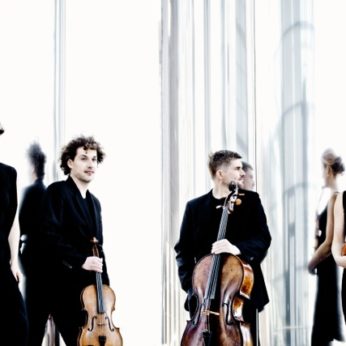Composer: Wolfgang Amadeus Mozart (b. 1756 - d. 1791)
Performance date: 27/06/2015
Venue: St. Brendan’s Church
Composition Year: 1785
Duration: 00:26:49
Recording Engineer: Richard McCullough, RTÉ lyric fm
Instrumentation: 2vn, va, vc
Instrumentation Category:String Quartet
Artists:
Signum Quartet (Kerstin Dill, Annette Walther [violins], Xandi van Dijk [viola], and Thomas Schmitz [cello]) -
[quartet]

This is the fourth of the set of six string quartets
known as the Haydn Quartets, which
Mozart wrote between 1782 and 1785, when he had settled in
name for himself as both a brilliant pianist and a free-lance composer,
particularly following the success of Die
Entführung aus dem Serail. Haydn, the first great composer of
string quartets, wrote his Op.33 set of six quartets in 1781 ‘in an entirely new and special style’, and Mozart was
so powerfully affected by them that he was inspired to spend more time
composing chamber music. They met in December 1781, possibly at one of the quartet
parties described by the Irish tenor Michael Kelly, where the players were
Haydn, Dittersdorf, Mozart and Vanhal. Mozart published the six
quartets with a long, highly personal and revealing dedication to Haydn: ‘… Here they are then, O great Man and my dearest
Friend, these six children of mine … the fruit of long and laborious endeavour
… You yourself, dearest friend, told me of your satisfaction with them during
your last visit to this capital … May it therefore please you to receive them
kindly and to be their Father, Guide and friend! …
In February, 1785 Haydn and
Mozart’s father Leopold were present at a quartet party at which some or all of
Mozart’s six new quartets were played, and Haydn, the most celebrated composer
in Europe, said to Leopold, Before God,
and as a man of honour, I tell you that your son is the greatest composer known
to me either in person or by name. He has taste, and what is more, the most
profound knowledge of composition. Unfortunately, most music critics were
not so perceptive, and a Viennese journalist wrote in 1787: It is a pity that he aims too high in his
artful and truly beautiful compositions, in order to become a new creator … his new Quartets … which he has dedicated
to Haydn, may well be called too highly seasoned – and whose palate can endure
this for long? Leopold Mozart was of the opinion that the last three
quartets were somewhat easier than the first three, and that K.458 was a little on the light side, but splendidly
composed. The long and laborious
endeavour was because Mozart had
abandoned the easy Italianate style of his earlier quartets and these, his
first mature string quartets, required much correcting and re-working. But one
result was that he learned to think in four parts at will, instead of in terms
of harmonised melody, and all the quartets have a spontaneous freshness and a
wonderfully fluent technique.
As
its nickname implies, K.458 opens in 6/8 time with the call of a hunting horn.
All of the subsequent material in the first movement is derived from the first
twelve bars, including the second subject, which begins as a five-note turn
after the hunting call theme has been extensively elaborated. The movement ends
with an emphatic coda. The second movement is an elegant minuet, although the accents
in the minuet do not follow the normal pattern, but the feeling of heaviness
and seriousness that this produces is offset by the perkiness of the delightful
trio.
The
lyrical slow movement is one of the most poetic slow movements in the whole
set, and it has an emotional profundity only previously achieved in K.428,
Mozart’s third Haydn Quartet. It is
dominated by the ethereal first violin part and a concertante dialogue with the
cello. It is the only slow movement in the set of six quartets that is marked Adagio, and to Mozart, as to all 18th
century composers, this indicated expressive intention as well as tempo. At
some points in the movement we are not aware of homage to Haydn so much as a
foreshadowing of the mature Beethoven. The cheerful sonata form finale is once
more in the Haydn tradition, although the lyrical expansiveness of certain
sections is pure Mozart. There are three distinct themes, the most important of
which is the spirited rondo-like first subject that provides the material for the
strikingly vigorous contrapuntal development section.
Copyright © 2025 West Cork Music. All rights reserved.
Designed and developed by Matrix Internet